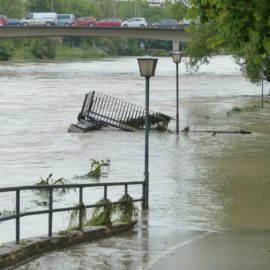
With flood insurance rates expected to rise residents want transparency from insurance companies. Do the companies know what that means?
Tommy Phillips was so worried that he went to his insurance agent to get some answers – and they weren’t good. Phillips, who lives near Boutte in St. Charles Parish, near levees, a canal and a pumping station, heard about changes on the way for the nation’s flood insurance program and wanted to know how much more he’ll eventually have to pay. FEMA has not yet provided that information, so he asked his insurer to quote him a rate as if it were a newly built house. The price he ended up with was more than $8,100 annually. Phillips currently pays $567 – making it an increase of more than 1,300%, to be phased in over multiple years for a house that has never flooded. He lives in an area where flood insurance is required. “That’s just ludicrous to think of that,” said the 52-year-old, who moved into his 2,400-square-foot in 2003, when it was new, and raised his two children there. “People can’t afford it. They can’t pay it. So what happens to their homes? They’re going to have to default their mortgages.”
theadvocate.com
What are we supposed to do? I had to bet flood insurance to buy my house so if I can’t afford it what happens.
Louisiana homeowners who currently have flood insurance will begin seeing the impact of a drastic overhaul of the program next month, but there are concerns that few understand the changes or their implications. With big increases on the way for many, public officials and residents accuse FEMA of leaving the public in the dark by failing to sufficiently explain the new system and the effect it could have on the state’s housing market. FEMA says the changes will make the program more fair and more solvent, but early results have provoked worry and growing calls for greater transparency. Louisiana’s two Republican U.S. senators, Bill Cassidy and John Kennedy, on Monday announced they had filed a bipartisan bill that would require FEMA to provide tools to help policyholders understand what their new rates are likely to be. The bill is co-sponsored by Sen. Kirsten Gillibrand, D-N.Y. Even some in the industry say they haven’t been provided enough information to fully understand how the new rates will be set under what is known as Risk Rating 2.0. An executive for a company that sells thousands of flood insurance policies says she has yet to be provided with details on how base rates are being calculated.
Louisiana will be hit as we do flood. Others do as well and they are in the same bind.
The stakes are huge for Louisiana, which has the nation’s highest participation rate in the National Flood Insurance Program. Its coast is largely a working one, home to shrimpers and roughnecks rather than seaside mansions. Major increases, even phased-in, could reshape parts of the housing market and weigh on mortgages. But so far, FEMA has provided only limited information, while seeking to reassure anxious policyholders and public officials that the new system will be equitable for all. It has only published data on monthly increases and decreases for the first year after the program takes effect, masking the true, long-term impact. Because the program’s rules cap annual increases for existing policyholders at 18%, the initial increases don’t really tell the story. Using data provided so far, an analysis by The Times-Picayune | The Advocate shows that around half of the state’s policyholders are expected to see phased-in increases that will total more than 129%. About one in 10 could see their premiums jump by more than four times their current amount, while around 20% are expected to see decreases
FEMA says it is to show the “real” risk as climate change makes storms fiercer.
The idea behind the new system is to more accurately account for flooding risk. FEMA says that under the old system, policies for newer, more expensive homes were essentially being subsidized by those for older houses that are less costly to repair. Policies for pricey beach houses should not be artificially low thanks to comparatively higher rates for working-class homes, according to FEMA and a range of organizations that support the changes. Beyond that, the changes aim to have the NFIP function more in line with private-sector actuarial standards, which could help address its gigantic debt, currently at around $20.5 billion. Hurricane Katrina was a main cause of that debt, accounting for more than $16 billion in paid NFIP claims. But as many have pointed out, flooding happened then because the federal government’s levees failed. “It was a man-made failure. I think when people are at fault for doing something, they need to be held responsible, not us through higher insurance rates,” U.S. Rep. Garret Graves, R-Baton Rouge, who attended the Luling town hall, said to applause from the several dozen people in attendance.
The new costs started been applied in October so are being felt now.
Since October, new policies are being priced at the full rates immediately, and that’s where the first shocks are being felt. The price quoted to Phillips was especially steep, and it’s unclear if his actual policy will be in that range. But it’s also not outside of the realm of possibility, considering some of the early returns. Graves called the new system a “flawed strategy” and urged better communications from FEMA. “We have seen just surges in rates,” he said. “Rates going from $560 a year to $6,000, $7,000 a year or more in St. Charles and Lafourche parishes and in other areas.”
FEMA, of course, defends the new costs.
FEMA defends the new system, saying it “demonstrates the real risk that current policyholders are facing so that they can be properly informed.” It has proposed granting assistance for those who can’t afford it, but that would require approval from Congress. FEMA had not responded to a question on whether any such assistance was approved last week as part of a massive government funding bill. One major point of contention involves what homeowners see as a bait and switch. They argue they bought their homes and planned investments under the old system based on flood maps, which they could understand. Now a complicated algorithm is being used to set new rates that may have nothing to do with the old ones. As one example, a FEMA representative was asked at the Luling meeting about homes that were built to a required elevation under the old rules, but could now be penalized because of the changes. “I wish I had an answer for that question, sir,” said FEMA official Gilbert Giron. “The structures were built compliant. They were built on data that we provided.” Giron then sought to explain why the changes were being made and the flaws in the old system to the skeptical audience. “The thing that they were not built on was a risk assessment,” he said. “They were built on the location on a paper map. Now I’m sure a lot of you know that water is not going to stop because there’s a line on a piece of paper saying that this is the end of the flood zone.”
A lot of factors are included in the new rankings.
Risk Rating 2.0 sets prices based on a complicated series of factors. Unlike the old system and its map-based formula, the new one looks at characteristics of each individual home. Those factors include distance from water, levee quality, foundation type and cost to rebuild. It also seeks to account for more types of flooding. One factor that remains perplexing to many is how the new system will account for elevation. Sample worksheets combine a home’s individual characteristics with a base rate per $1,000 of coverage value to come up with a quote. But it’s unclear what goes into the base rate. “They did not inform us of how they came up with those base rates,” said Patricia Latshaw, a senior vice president for Florida-based Wright National Flood Insurance, which says it is the nation’s largest seller of NFIP policies. Asked about transparency from FEMA, she said “there has been some transparency, but really what makes it difficult is we can’t look inside (the new system) to see how a building is rated.”
Our congressional delegation is working for us, or are the standard 3 carrying the ball for the other 4.
The state’s congressional delegation has sought to delay Risk Rating 2.0’s implementation as well as reduce the cap on annual increases, among other changes. In addition to his new transparency bill, Cassidy has highlighted a FEMA internal study saying nearly 20% of policyholders could drop out of the program over a decade. FEMA says the study used “pessimistic assumptions” and it expects enrollment to increase. From what Phillips has seen, he believes the outcome in south Louisiana will be severe. He worries the levees near his home are not being accurately accounted for, and believes the new rates could have a devastating effect on communities. He says “the whole thing is just not clear as to what’s going on.” “This is more about the culture we have in south Louisiana and how it is going to be destroyed if it’s not changed,” he said.
If I really get hit do I stay and suck it up or stay and sell to rent, or do I say enough is enough and move. Each of us will have to make that decision.



